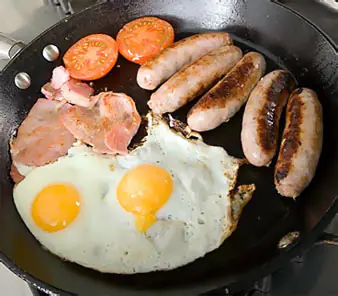It is possible to get rid of extra pounds without reducing the number of calories you consume. It comes down to forcing the body to use not glucose as an energy source, but fats that it has stored “for later.” The name of this diet was given by ketosis bodies, which are produced by the liver as a result of consuming carbohydrates in the very minimum amount (100 g per day). Protein and fat also contribute to ketosis, but only when it comes to total calories.
Pros and cons of the keto diet
For the body to function, proteins, fats, and carbohydrates are necessary. But if the latter are excluded from the diet, he will turn to free fatty acids found in subcutaneous fat for help. Therefore, the first advantage of the keto diet is its high efficiency, because the body cannot live without energy and the breakdown of fats begins in the first hours after giving up carbohydrates. In this case, muscle mass is not lost, and extra pounds do not return.
The body does not immediately adapt to the absence of glucose, so the first and biggest disadvantage is a decrease in performance and mental activity when switching to a keto diet. Digestive disorders are also possible due to the lack of fiber, but this can be mitigated by consuming, for example, MCC or salad containing a sufficient amount of coarse dietary fiber. Already on the fifth day, the body will adapt to the new working conditions and performance will be restored. However, this diet is not recommended for heavy physical activity.
Another disadvantage of the keto diet is the insufficient amount of microelements for the body, which only carbohydrate foods can provide it with. But the most important thing is that ketones in the blood increase in direct proportion to the decrease in pH in the body, which can be fatal for diabetics. A healthy person, even on a keto diet, is able to process the ketones produced, but it is better to consult a nutritionist for advice.
Foods you can eat on the keto diet
The keto diet in terms of the products consumed is reminiscent of the well-known Kremlin diet, as well as the Atkins diet, but the products themselves are not so important as their quantity. It is very important not to eliminate the consumption of carbohydrates completely, but to reduce it to a minimum. The best option is 100 g per day (50 g each for the brain and muscles).
All foods that do not contain carbohydrates are suitable for consumption. It doesn't matter how many calories you consume. True, a normal woman who does not have additional physical activity should still not exceed the level of 2000 calories per day, even if she feels exhausted in the first days.
Completely excluded:
- cereals,
- bread,
- grapes and bananas,
- carrots, beets,
- pasta
- potato
- sugar,
- bakery.
Dairy products and meat are consumed in normal quantities. It is best to eat turkey or chicken meat, and fish - tuna, salmon and herring. The number of eggs, skim milk and fermented milk products is not limited.
Sample menu for one day
Many nutritionists recommend starting a ketogenic diet from fasting, when you need to consume only water in unlimited quantities. In this case, physical activity should be kept to a minimum.
Starting from the third day, non-carbohydrate foods are gradually added to the diet (1/3 of the usual serving). On the sixth day, if the body responds normally to changes, the amount of food should already be increased to the appropriate level.
So, let's look at an approximate menu for one day if you decide to resort to a low-carbohydrate diet. Then you can allow any variations in products, excluding prohibited ones and avoiding exceeding the norm of consumed calories.
For breakfast you can eat buckwheat porridge or three boiled eggs, boiled tongue and a salad of boiled beets with vegetable oil, washed down with tea.
For lunch - cabbage soup with wholemeal bread, Greek salad with boiled brisket, washed down with dried fruit compote.
For now



